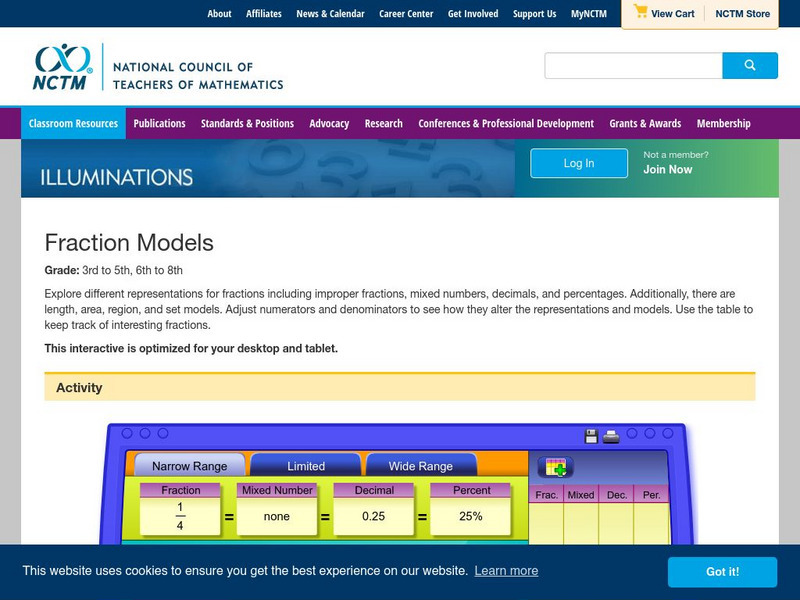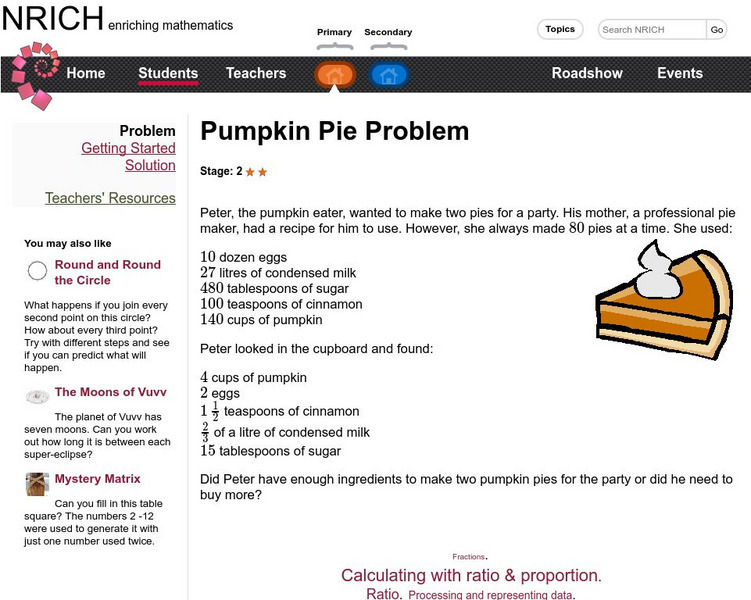Curated OER
Parts of a Whole
Learners gain an better understanding of how to figure out parts of a whole.
Curated OER
Finding Remainders in Pascal's Triangle
Students use clock arithmetic to find remainders. For this patterns in math lesson, students explore the relationship between clock arithmetic and remainders using a computer applet. Students also identify patterns in Pascal's triangle...
Curated OER
Maps
Students figure out the mileage from one state to another using a map. In this map lesson, students look at the scale factor and turn it into a fraction. They measure the distance between two cities and use the proportion to find the...
Curated OER
Unexpected Answers
Students consider probability problems with unexpected and surprising answers.
Curated OER
Two-Dimensional Drawings from Three Dimensional Objects
Sixth graders identify and replicate two dimensional illustrations of three dimensional objects. In this spatial visualization lesson, 6th graders practice viewing objects from various sides. Student participate in stations to view...
Curated OER
Estimation With Percents
Students examine percents. In this percents lesson, students will estimate percentages. Using advertisements from a newspaper, students problem solve to determine the final price of a sale item.
Curated OER
Grid and Percent It
Students explore percent. In this percent activity, students investigate how to represent percentages on a hundreds grid. Working independently, students solve mathematical problems involving percentages.
Curated OER
Build a Snowplow
Pupils design and build a snowplow using LEGO materials. They compete in an Engineer's Challenge to clear a path through Styrofoam peanuts.
Pennsylvania Department of Education
Seeing Doubles
Pupils work with dominoes to recognize the number of spots on each side as they relate to addition facts. In this seeing doubles lesson, students make triangle shaped flash cards for the double facts. Pupils represent the correct...
Curated OER
Math: Am I Prime?
Seventh graders determine the difference between prime and composite numbers. On a Website, they discover a method to identify all the prime numbers up to 100 and also complete several online activities. Once they have discussed the...
Curated OER
Percentages On A Grid
Fifth graders show percentages on a 10 x 10 grid. In this percentages lesson plan, 5th graders color in the squares to show a percent.
Curated OER
Coin Drop
Students calculate the theoretical and empirical probability by dropping coins on a grid. They record their data and compare the theoretical and empirical data. Students make predictions about the results before conducting the experiment.
Curated OER
Roll `Em!
First graders engage in using base ten blocks and dice for a fun engaging math lesson. They use a worksheet imbedded in this lesson as the game board to help them play this math game.
Curated OER
Two-Dimensional Drawings from Three-Dimensional Objects
Sixth graders identify and draw two-dimensional representations of a three-dimensional object. Students investigate the views of an object and determine that three views are required (front, one side and the top). Students use these...
Curated OER
Mammoth Sunflower Problem
Students discuss the directions on a package of seeds. They open the package, count the seeds, and determine the planting requirements for the seeds.
Curated OER
Unexpected Answers
Students explore and complete a variety of activities demonstration probability. They make observations about the results of the activities. Students complete and discuss conditional probability. Also, students draw conclusions about...
National Council of Teachers of Mathematics
Nctm: Illuminations: Fraction Models
Explore different representations for fractions including improper fractions, mixed numbers, decimals, and percentages. Additionally, there are length, area, region, and set models.
National Council of Teachers of Mathematics
Nctm: Illuminations: Fraction Models
Numerator values can be set for 0-20. Denominator values restricted to 1, 2, 4, 5, 8, 10 and 20. Use this interactive tool to show a fraction. Adjust both the denominator and numerator and see a visual representation as a part of a...
Scholastic
Scholastic Lesson Activities: Model With Manipulatives
Two fraction activities are highlighted at this one page website. Both use manipulatives to help students begin to understand the basic concepts of fractions.
Better Lesson
Better Lesson: Compare Parts of a Whole
Given a set of fractions students will be able to compare unit fractions by using models to determine that the more equal parts there are in the whole, the smaller each part will be. This instructional activity includes a detailed plan,...
The Math League
The Math League: What Is a Fraction?
This tutorial helps students to understand fractions. It explains what denominators and numerators are using simple graphics.
University of Cambridge
University of Cambridge: Nrich: Pumpkin Pie Problem
On this one page website sharpen your logic, graphing and pattern recognition skills while working on this challenge. The solution is available to double check your solution.
Alabama Learning Exchange
Alex: Decimals: The Master of Many Disguises!
In Cooperative/Collaborative groups, this lesson will actively engage students to represent decimals in different forms. An "Essential Question" will be used to activate background knowledge and set the purpose for understanding how to...





















